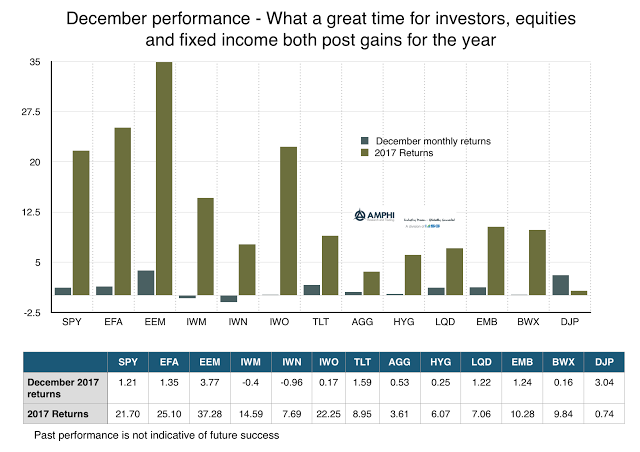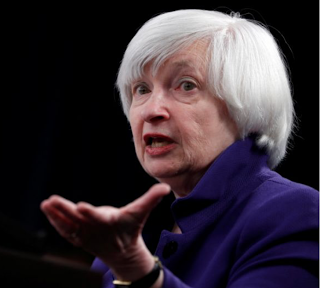Category: Uncategorized

This Investing is Easy! Everything Positive for 2017, But Unfortunately We are Starting a New Year
Many pension and endowments are going to post double-digit returns for 2017. Most have exceeded their actuarial expect return assumptions of 7%. Family offices and general investors have also posted good returns for the year.

Forget About Overvalued Equities – Forecast Survey Expects 6% – Optimism Still Exists
Perhaps the market analysts making 2018 forecasts for the S&P500 did not get the memo on valuation. The equity markets are overvalued by most any measure, yet the median forecast is still expecting a 6% total return in the year-end Bloomberg survey.

Add Mental Models for the New Year – Broadening Your Thinking Process Will Improve your Productivity
Most New Year’s resolutions focus on the physical, “I will exercise more, eat less.” A better resolution should focus on mental muscles like, “I will add some mental models to my thinking.” This may help better manage time and effort and allows you to undertaken tasks more efficiently.

Mean Reversion Is Not the Same as Contrary Thinking. A Big Confusion for Many Managers
Disagreeing with the consensus or trend is not always contrary thinking or mean-reversion thinking. It is sometimes being different for the sake of being different.

Is a Bond Bust More Likely Than an Equity Sell-Off? Look For Alternatives
The major drumbeat of asset class overvaluation has focused on equities, but perhaps a scarier place to invest is holding long duration bonds. Both asset classes may be overvalued, but a close look at the economic fundamentals may suggest that greater concern should be with bonds.

Back to Basics for Trend-Following – It is All About What It Does to the Portfolio
It does matter what an investment strategy will do on a stand-alone basis; however, it really matters what an investment will do when added to an already diversified portfolio. For any strategy allocation decision, it is all about the marginal contribution to portfolio return and risk. Most investors know this intuitively, but they often do not focus on the marginal portfolio contribution in practice.

Buy the Losers and Sell the Winners? Reverse your Thinking and Be Careful About Avoiding or Exiting Losers
The general view is that an investor should pick good managers who have had a track record of success, but a more nuance look at data suggests that buying when good managers underperform can be valuable. Whether past performance provides some indication on future success has been one of the key issues facing any investor. We now have an interesting perspective from Brad Cornell, Jason Hsu, and David Nanigian in their Journal of Portfolio Management paper, “Does Past Performance Matter in Investment Management Success”.

Buy in a Drawdown? Focus on Future and not the Past Performance
Managed futures, as a hedge fund strategy, have moved off of its max drawdown since June, its worst drawdown in the last five years, as measured by the SocGen CTA index. For some investors this type of drawdown means an exit from the strategy; however, some of the broader data on manager selection suggest a different approach. The idea of being careful about making investment decision based on a drawdown is consistent with the mean reversion performance analysis of winners and losers.

Not Buying the Fed Package – The Fed, Yield Curve, and Bonds
The take-away quote from Yellen this week, “The relationship between the business cycle and the yield curve may have changed.” There was little supporting evidence for her view. It is the hope of the Fed that further rate increases which may further flatten the yield curve will not reverse the current course of the economy.

Producing Alpha Is Not Easy – The Solution to Making Effective Decisions in an Uncertain World has not Been Found
“What I think HBS does and does very well is train people to, in situations of ambiguity, to take imperfect information, uncertain outcomes, and tight deadlines and figure out what to do in the most effective, efficient, and powerful way.” – Casey Gerald from The Golden Passport: Harvard Business School, the Limits of Capitalism, and the Moral Failure of the MBA Elite by Duff McDonald

Financial Conditions – No Signal of Tightening. Trend Says Stay the Course with Risky Assets
The Fed has become more focused on financial market conditions since the Financial Crisis. There is less interest in the classic goal of managing full employment since by many measures we may beyond the natural rate of full employment, and there is admitted confusion on how to control inflation.
Equity Asset Class Value Rotation – Look Outside the US for Upside and Protection
The talk has focused on the overvaluation and “bubble” with US stocks, but there are other relative opportunities in risky equity assets. A comparison of CAPE across the world shows that the UK, euro area, and Japan valuations are closely tied together, significantly below highs from 2008, and all relatively cheap versus US.

“Risk of a Rapid Repricing in Global Markets” – (ECB) With this Narrative, Investors Need Strategies that Generate Portfolio Gamma
“Risk of a rapid repricing in global markets”; this ECB quote was a key talking point in the press release from the ECB Financial Stability Report issued last week. Note that “rapid repricing” is a polite way of saying asset price declines.